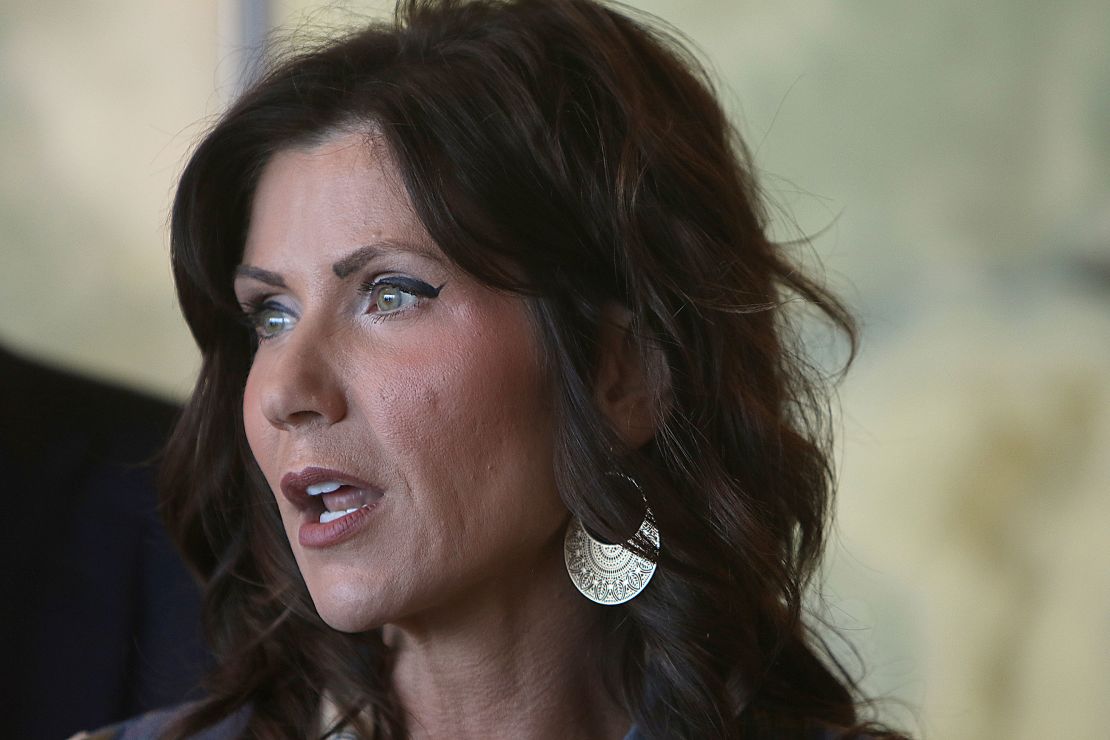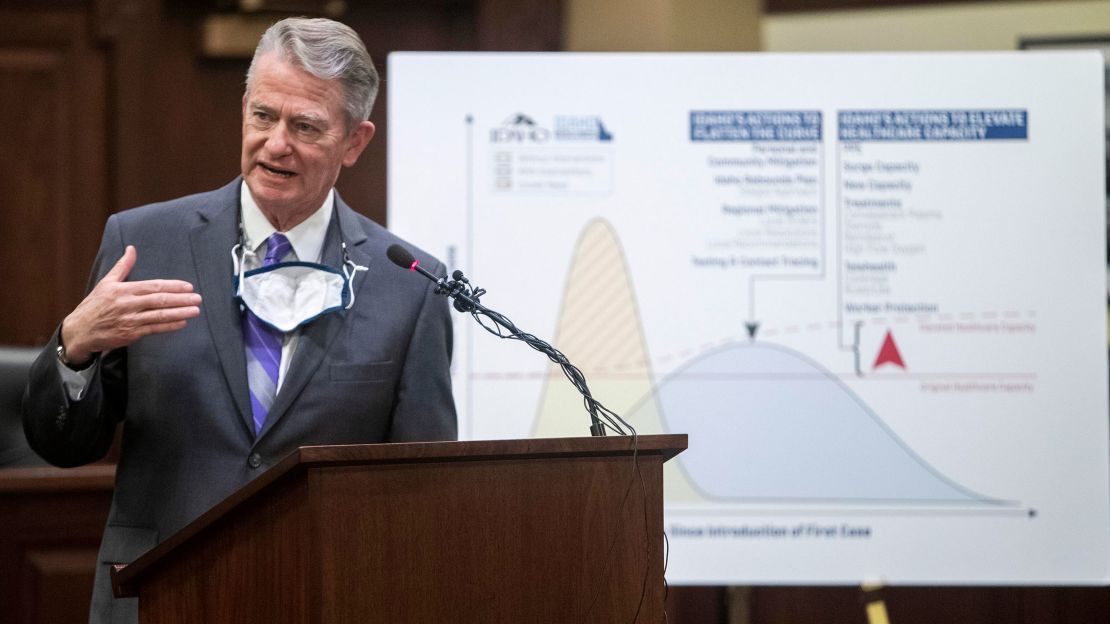Since Covid-19 hit US shores, Republican governors in the Upper Midwest and Northern Plains have largely taken a hands-off approach. The results of that strategy have been poor.
When adjusted for population, no states have had more new Covid-19 infections, hospitalizations and deaths over the past seven days than North and South Dakota. The nearby states of Iowa, Wyoming, Nebraska and Idaho are not far behind.
This surge has pushed hospitals to the brink even as businesses have struggled to keep up a healthy work force. In response, several of these governors have acknowledged the failures of their permissive strategies and pushed for stricter health rules and mask mandates to prevent the virus’s spread.
“We’ve relied on people to be responsible,” Wyoming Gov. Mark Gordon said Friday, “and they’re being irresponsible.”
Yet other governors, including in South Dakota, have continued to resist taking actions like requiring masks.
Here’s a look at how these governors have dealt with the fall surge.
South Dakota Gov. Kristi Noem

Gov. Kristi Noem, a Republican in office since 2019, has adopted much of the language of President Donald Trump during the pandemic.
She has resisted restrictions on gatherings and given credence to those who question whether masks are helpful in stopping an airborne virus.
“There are many others who question the effectiveness of masks, and South Dakotans should take the time to read this information so they can make informed decisions for themselves and their families,” she wrote in an op-ed last month. “As I’ve said before, if folks want to wear a mask, they should be free to do so. Similarly, those who don’t want to wear a mask shouldn’t be shamed into wearing one. And government should not mandate it.”
Noem has also encouraged crowded gatherings with no social distancing, in particular at a Trump rally at Mount Rushmore in July.
The results have been devastating health-wise. South Dakota has averaged more than 1,400 new coronavirus cases per day over the past week in a state with about 885,000 people. Adjusted for population, it’s the second-highest number of new average cases in the country. The state’s seven-day positivity rate is a stunning 58%, and more people are hospitalized per capita than in any other state, according to the Covid Tracking Project.
Jodi Doering, a nurse at a South Dakota emergency room, said some people dying at the hospital are still in denial about the virus.
“They don’t want to believe that Covid is real,” she said. “Their last dying words are, ‘This can’t be happening. It’s not real.’ “

Despite the rising health disaster, Noem said Friday that her strategy has worked.
“I knew that South Dakotans could be trusted to exercise their personal responsibility, and each and every one of these people have proven me right,” she said in a statement.
North Dakota Gov. Doug Burgum

Gov. Doug Burgum, a businessman who was elected as a Republican in 2016, had resisted a mask mandate since the pandemic began.
But that stance became untenable in recent weeks as Covid-19 has run through the state. Per capita, North Dakota has the most new coronavirus cases and deaths over the past seven days of any US state, and is second in new hospitalizations only to South Dakota.
Citing the state’s overwhelmed hospitals and health care workers, he issued new rules last week that allowed infected health care workers to continue working in hospital Covid units as long as they are asymptomatic.
Over the weekend, he issued health rules for the public that require people to wear masks indoors and limit indoor gatherings.
“Right now, the data demands a higher level of mitigation efforts to reverse these dangerous trends, to slow the spread of this virus and to avoid the need for economic shutdowns,” Burgum said in a video message announcing the measures. “Our situation has changed, and we must change with it.”
The mask mandate has exceptions for children under 5, individuals with conditions or disabilities that make it “unreasonable” to wear a mask, and for religious services, even though they have been the source of several outbreaks.
In addition, Burgum’s executive order limits the capacity of people in bars, restaurants and event venues.
“We believe in North Dakotans. We believe in the power of individual responsibility. And we need individual responsibility now more than ever to slow the spread of Covid-19,” Burgum said.
Wyoming Gov. Mark Gordon
In the country’s least populous state, Gov. Mark Gordon, a Republican who took office in 2019, did not issue stay-at-home orders in the spring and has not required people to wear masks.
Yet after months of advising residents to take “personal responsibility” to protect themselves, he admitted Friday that the strategy had failed. Wyoming has the fourth-highest number of daily new coronavirus cases per capita over the past seven days, along with sharply rising hospitalizations and deaths.
In a news conference brimming with frustration and anger, he called people “knuckleheads” for their irresponsible actions and said it was “time that Wyoming woke up and got serious about what it’s doing.”
The virus itself has compromised the workforce more than any government actions, Gordon said.
“We’ve had more businesses around the state closed by sick workers than by any of our health orders,” he said.
Currently, the state has only minor restrictions in place and has allowed restaurants, bars, movie theaters and event spaces to remain open. But Gordon said he was considering a mask mandate as well as further restrictions on indoor gatherings if things don’t change.
“If I can’t rely on you, we’re going to have to do something else,” he said.
Iowa Gov. Kim Reynolds

Gov. Kim Reynolds, a Republican who assumed office in 2017, has resisted mask mandates and shutdowns for months.
Last month, she attended a Trump rally without a mask, violating her own rules on gatherings. She has ignored increasingly dire warnings from the White House coronavirus task force to institute a mask mandate over the past few months.
Now, Iowa is behind only the Dakotas in its measure of new coronavirus cases when adjusted for population, and the state has the fourth-highest number of people hospitalized per capita. Its seven-day positivity rate is more than 50%, behind just South Dakota and Wyoming.
And so on Monday, Reynolds overcame her resistance and instituted a new health order requiring masks indoors and further limiting indoor gatherings to 15 people.
She said hospitals have been pushed to the brink by the spread of the virus, and she accused many Iowans of becoming “complacent” about the need to flatten the curve.
“That doesn’t mean that these changes will be easy or popular, but they’re necessary if we want to keep our businesses open, our kids in school and our health care systems stable,” she said.
Nebraska Gov. Pete Ricketts

Gov. Pete Ricketts, a Republican businessman who has served as governor since 2015, went further than almost any other governor in his resistance to mask mandates.
In June, he told local government officials that they won’t get federal coronavirus relief funding if they require individuals to wear face masks in government buildings. He said masks should be encouraged but not required, and put the enticement of CARES Act money behind that position.
Months later, and still with no mask mandate, the state has seen huge surges in coronavirus cases. Adjusted for population, Nebraska has the fifth-most new cases over the past week and the third-most people hospitalized.
“This is a very serious situation for our hospitals, and we need to be a part of slowing down the spread of this virus,” he said Friday.
The level of restrictions in the state are based on the state’s hospital bed availability, but even the restrictions are fairly minor.
The state currently has 20% of its hospital beds taken up by people with Covid-19, putting it in the “Orange” status. That means bars and restaurants can remain fully open, while other indoor gatherings are limited to 25% of normal capacity.
Ricketts also asked people to wear masks but pushed back against statewide requirements, saying, “I am in favor of educating people.”
He spoke Friday while self-quarantining at home with his wife after a dinner guest tested positive for Covid-19. He has tested negative for the virus.
Idaho Gov. Brad Little

Idaho’s outbreak is not as dire as those of other nearby states – per capita, it has had the 17th-most new infections over the past seven days.
Even so, Gov. Brad Little, a Republican who took office last year, admitted that the strategy so far, with no statewide mask mandate and few restrictions on gatherings, has not been effective. He particularly said the public education on mask-wearing has been inadequate.
“We’ve come to the profound conclusion that what we’ve been doing hasn’t been working,” Little said Friday.
Half of Idaho’s population is under local mask mandates, he said, but people are not complying or are taking their masks off in private social settings. Hospitals are warning that they may soon have to start rationing care.
So on Friday LIttle announced he is signing a public health order rolling the state back to Stage 2 of its reopening plan, prohibiting gatherings of more than 10 people both indoors and outdoors, except for religious and political gatherings.
Little did not issue a statewide mask mandate, but he did call up 100 members of the National Guard to support the health care system.
“Our hospitals and other health care providers are telling us too many health care workers across Idaho are out sick with Covid, and they are contracting it within the community. And doctors and nurses who are healthy are overworked and burned out,” he said.
CNN’s Artemis Moshtaghian, Raja Razek, Gisela Crespo and Nakia McNabb contributed to this report.


























